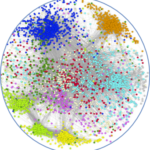Link to Pubmed [PMID] – 37234533
Link to DOI – 10.3389/fmicb.2023.1148233
Front Microbiol 2023 ; 14(): 1148233
Brucella abortus is a zoonotic pathogen whose virulence depends on its ability to survive intracellularly at the endoplasmic reticulum derived compartment. The two-component system BvrR/BvrS (BvrRS) is essential for intracellular survival due to the transcriptional control of the type IV secretion system VirB and its transcriptional regulator VjbR. It is a master regulator of several traits including membrane homeostasis by controlling gene expression of membrane components, such as Omp25. BvrR phosphorylation is related to DNA binding at target regions, thereby repressing or activating gene transcription. To understand the role of BvrR phosphorylation we generated dominant positive and negative versions of this response regulator, mimicking phosphorylated and non-phosphorylated BvrR states and, in addition to the wild-type version, these variants were introduced in a BvrR negative background. We then characterized BvrRS-controlled phenotypes and assessed the expression of proteins regulated by the system. We found two regulatory patterns exerted by BvrR. The first pattern was represented by resistance to polymyxin and expression of Omp25 (membrane conformation) which were restored to normal levels by the dominant positive and the wild-type version, but not the dominant negative BvrR. The second pattern was represented by intracellular survival and expression of VjbR and VirB (virulence) which were, again, complemented by the wild-type and the dominant positive variants of BvrR but were also significantly restored by complementation with the dominant negative BvrR. These results indicate a differential transcriptional response of the genes controlled to the phosphorylation status of BvrR and suggest that unphosphorylated BvrR binds and impacts the expression of a subset of genes. We confirmed this hypothesis by showing that the dominant negative BvrR did not interact with the omp25 promoter whereas it could interact with vjbR promoter. Furthermore, a global transcriptional analysis revealed that a subset of genes responds to the presence of the dominant negative BvrR. Thus, BvrR possesses diverse strategies to exert transcriptional control on the genes it regulates and, consequently, impacting on the phenotypes controlled by this response regulator.




